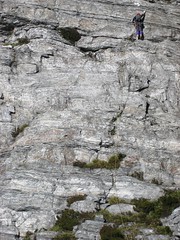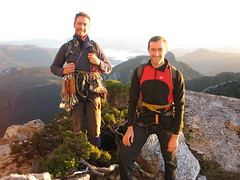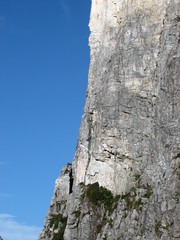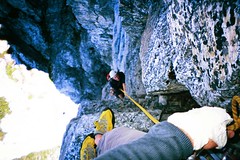
By Rod Smith
Beneath the massive half-dome of Frenchman’s Cap my courage shattered and fell like a shard of quartzite rock kicked from the summit.
As the 7am summer sun warmed the white rock of the distinctive 1446m peak in South-West Tasmania, all that I could think of were reasons not to climb.
“I’m not doing it, I’m coming down,’’ I announced to my climbing partner Gus Davidson and Simon Kearney, who’d come along for the walk.
The first mistake was skipping coffee. The second was believing that the cold, shaded, crumbling, overhanging gully could possibly be the start of Tierry Le Fronde. The third was heading up it.

When I finally decided to bail, it felt like a betrayal, but at that moment I didn’t care.
“Some times you have to obey the screaming little man inside, this is one of those times,’’ I sagely told Gus and Simon.
Then I sat down and, head in hands, began a mental battle: Screaming Little Man versus rational me.
In the meantime Simon and Gus wandered off, taking photographs of each other, and the magnificent surroundings.
Or so I’m told.
Oblivious to all, I sat for what turned out to be an hour trying to get back some mental equilibrium. Then I announced it was time that the three of us went and did something with the day. Perhaps a bushwalk, or a lazy day sitting in the sun at Lake Tahune, reading a book.
Over on The Sydney Route, I spied a tiny speck that the camera zoom showed was Nigel Donnelly belaying Mike Patterson who was negotiating the fifth pitch of Jack Pettigrew and Bryden Allen’s 1965 classic route.

Nigel, Mike, Gus and I had been training for weeks to climb the 380m, 13-pitch, grade 17 The Sydney Route.
When the allotted day came for Gus and me to head up the line the morning was wet and windy and we all went back to sleep, ignoring the intended 5am start. Later, in improving weather, we reconnoitred the route from its base only to find that its shady, upper pitches were wet.
Gus and I discussed the possibility of climbing and after gazing at it for a couple of hours we concluded that as a team, even if we had started on time and the rock had been dry, we probably weren’t up to the rigours of the route.
On that same day, as the four of us sat in the sun on top of Frenchman’s Cap taking in the views on a near perfect summer’s day, we firmed up our plans for the next day. Gus and I would seek a more achievable but no less worthy prize: Tierry Le Fronde a grade 16 climb of six pitches. Nigel and Mike would have The Sydney Route all to themselves.
But my plans to bag a classic were as if dust the next morning as I walked back up the steep descent gully after bailing off the climb. I felt angry as I studied the startling arête that Tierry Le Fronde follows for most of its 150m length. I felt unworthy to be carrying the rack of Friends and Hexes that dragged around my neck.
Then I thought of the sheer efforts we’d made to be here. How our six-man party had carried 30kg-plus packs in 30-degree plus weather. How we’d grunted up hill and down dale to gain 900m vertical height, spent hours negotiating the energy-sapping Loddon Plains bogs before finally collapsing at Lake Tahune after slogging 25km in two days. Not to mention the logistics of getting everyone and their gear to South-West Tasmania.
It’s true that we were all fatigued from the massive efforts of the walk in – by trip’s end and despite eating massively I had lost almost 5kg. But if the walk was a difficult grind then the climbing was meant to be the pleasurable reward. Now here I was about to throw it all in. It seemed so selfish, impotent and just downright rude.
I stopped, uncoiled the rope and said to Gus “I think I’ll just head up here for a look”.
Thirty metres off the deck, climbing in the sun on an easy angled-slab I placed my first piece of protection and everything felt right. “I think I’ll keep going,” I told Gus.
We were on the way.
For the next six hours the pair of us revelled in the challenge of this classic route. Sustained and exposed, it follows the shadows to the left-hand side of the main arête up the Tahune face.
After the 45m long slabby non-pitch to a big ledge, the first pitch led up a pleasant sun-illuminated wall before gaining a small stance and ducking into the shadows.
I inadvertently strung together the second and third pitches. That 56m mega-pitch provided some of the most enjoyable climbing that I have ever done. It was here that the crux appeared about the same time as a rusted and bent-over piton, possibly placed by the first ascentionists – Chris Dewhirst and Phillip Stranger in 1968.
Despite repeated attempts to clip the piton I was forced to climb on, the distance between me and my last piece of protection growing longer.
Interestingly I remember feeling no fear: instead I felt the thrill of being high up in an exposed position, stemming on small holds and engrossed in the task at hand. It was a task complicated by the dwindling amount of gear on my rack.
After a couple of attempts with wires I settled on a tiny cam. From there I ran it out to the top of the third pitch – an airy perch on an exposed pinnacle with huge views of the surrounding wilderness.

Tied into a number 10 hex that someone else had left behind, I brought Gus up. We both felt good and took a couple of photographs with my compact film camera to mark the occasion.
The next pitch began with a delicate unprotected traverse then up a not-so-delicate face to a large ledge. Then it was around the ledge and up to the base of a corner. Here Gus and I stood and gazed up at the impressive overhangs that provided the last obstacle to the top.
With the end in sight I led off and was soon among a series of overhanging quartzite fins. Some careful stemming around shifting blocks combined with some full-blooded hauling on more secure holds brought me to the final overhang. With one handjammed beside a protruding flake and searching for a cam, I looked down as my last bit of gear lifted out and slid down the rope. Six metres above my last piece of protection, I felt the protruding flake shift beneath the pressure of my jam.
Now beginning to feel vulnerable I quickly selected a cam and plugged it in beside the shifting flake before setting off and up and onto the belay seat. Gus quickly followed and we both stood on a small perch looking up at the exit, a sloping offwidth but easy chimney with which we quickly dispensed.
Sitting in the alpine bushes in the sun and finally eating our lunch, I felt happy and euphoric. As we took in the views I privately compared the now with the then of six hours previously when I’d begun the climb.
In the morning I had wanted to give the game away, now I wanted to climb forever.
Much later, Gus and I were relaxing back at Tahune Hut when the two-way radio went scratchy with static before seguing into Mike Patterson saying “Rod are you there? We’ve just finished?”. Ten hours and 13 pitches later Mike and Nigel were 400 vertical metres above us, descending down to the hut with Simon.
That night, over several shots of whisky, we traded tales about our day out on white rock under blue skies.